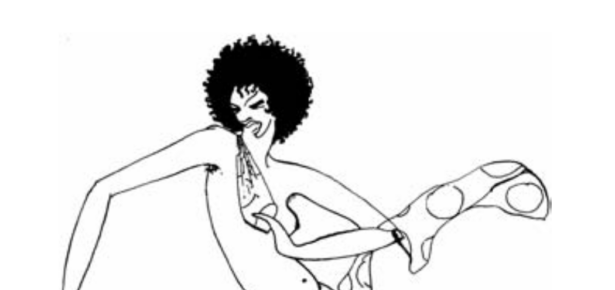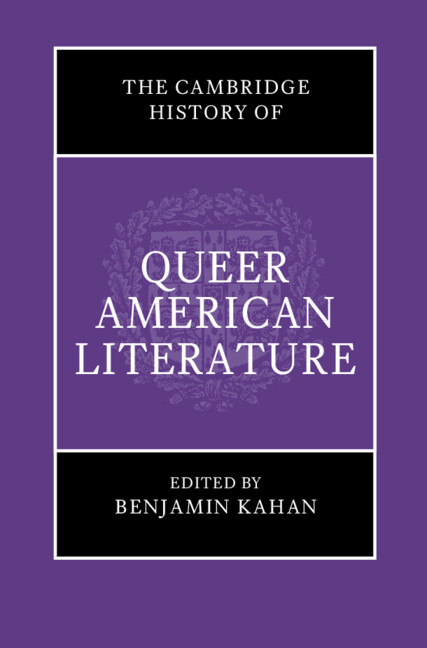
The Cambridge History of Queer American Literature brings together more than 50 scholars to provide a literary history of the queerness of American literature from its earliest beginnings to 2023. It takes as its remit the intense proximity, entwinement, and even identity between queerness and American literature. When the American literary scholar Eric Savoy asked the famed early practitioner of LGBTQ studies, Robert K. Martin, “if he had ever considered editing a collection of gay American writing. ‘It already exists,’ he responded. ‘It’s called The Norton Anthology of American Literature.’” In Martin’s joke about canon formation (where the Norton is a metonym for the canon), the canon’s queerness remains hidden in plain sight since the framing apparatus of the Norton does not help its readers to see such queerness. We might imagine The Cambridge History of Queer American Literature supplying some of the missing annotations.
As I was conceptualizing it, I wanted to celebrate, reflect on, and build on the work of LGBTQIA+ studies over the last 30 or more years as well as to try to push the field in new directions, placing emphasis where it was it lacking, opening new questions and new objects of study, and trying to create new knowledge that wouldn’t just memorialize or fossilize the field, but that would push it forward. I love queer criticism about Henry James, Walt Whitman, and Willa Cather, but you won’t find much of it in the volume. All of these figures are represented of course, but because there is so much already written on them, I wanted to offer new accounts and introduce authors lesser known. One of the ways that the volume recasts the field is by placing a great deal of pressure on each of the words in the title—thinking about what is at stake in the words “Queer,” “American,” and “Literature.” To ask: what even is queer American literature? Because an American literary work might be one set or partially set in America, written by someone with US citizenship status or living undocumented in the United States, energized by ideas of Americanness, or some other configurations entirely, and because a queer text might feature queer or gender-nonconforming characters, acts, desires, tropes, or be written in a queer style, or by an author who might be animated in some way by queerness whether through personal identification or fear, and because literature denotes oral and written systems of communication, stories carved into wood as well as those written in ink, or composed of bites, the question of what queer American literature is can have no definitive answer. The contributors instead offer a range of possibilities, repertoires of queer and trans relationality, tracing queer and gender-nonnormative American literary histories, and mapping American histories of queer sexualities and gender pluralities.
Simultaneously focusing on American literature and the history of sexuality, the volume is divided into six sections which examine American history, literary movements, genre, racial literatures, region, and methods. This kaleidoscopic and multiperspectival organization—rather than, say, by chronology or author—aims to cross-cut the field’s fragmentation and segmentation, reconstituting them not into a unity but an aggregation that is, in Eve Kosofsky Sedgwick’s phrase, “something like a whole.” Its multiperspectival history traverses and stiches together these segmented histories moving both synchronically and diachronically, a project which is also facilitated by both a section on and volume-wide attention to questions of method.
To give a more concrete sense of what I mean—allow me to give a few examples.
As I was writing the Introduction, it struck me that even though the fields of gay and lesbian studies and later queer and trans studies emerged primarily in the U.S. outside and inside the U.S. academy that there was not an obvious place to go for an institutional history of the field. My introduction furnishes an account of the roots of gay, lesbian, queer, and trans studies in sexology and sexual science, tracing how the field from the late nineteenth century is made possible through the advocacy of feminist, queer, and trans activists. Offering an account of how this scholarship and activism is translated into the classroom as the first classes in gay and lesbian studies are taught in the late 1960s, the Introduction maps a genealogy of the field formations of feminist, queer, and trans studies in their academic and para-academic spaces and sites of institutionalization—minors, concentrations, degree programs, conferences, journals, and book series. These sites of institutionalization very much emphasize a point that Matt Brim has made eloquently: namely, that these courses were all taught at state institutions, many of them quite poor. The first inklings of institutionalization did not result from the efforts of what Brim nominates as Rich Queer Studies schools–Yale, Harvard, and the other locations of privilege–but emerged without resources, through the scrap and gumption of activists.
Like this I wanted the volume to tell stories as yet untold. But at the same time what the volume makes clear is that American sexual and literary histories don’t have easily identifiable timelines. There is no obvious American equivalent to Oscar Wilde or of the Radclyffe Hall trials, which is not to say that these trials didn’t have an impact as historians like Amy Sueyoshi, William Eskridge, Peter Boag, Regina Kunzel, George Chauncey, and Leslie Taylor make clear, but the historiographical relation between American sexual history and the events that are often understood to provide the major landmarks of American history still remain somewhat fuzzy.
But it is my hope that the essays in the volume begin to clarify the relation between landmark events, literary history, and the history of sexuality. Chapters by Madoka Kishi and Tim Dean exemplify this project by charting what I call following Susan Lanser “the sexuality of history,” thinking about the ways history is sexually constructed. Kishi argues that late nineteenth and early twentieth century immigration restrictions somatize and enflesh the social body as vulnerable and polymorphously perverse, thereby rendering US immigration at the turn of the twentieth century a sexual event. Tim Dean traces the sexuality of history too, mapping the way that both the lived experience of and writing about HIV/AIDS shifts with “medical developments,” enabling him to theorize the queer temporalities of what he calls “the literature of PrEP.” Here, pre-exposure prophylaxis (PrEP) inverts the established temporalities of the history of epidemic with individuals “undertak[ing] a course of antiretroviral medications not after seroconversion but before it.”
The volume is thus not just a recording of the field as it stands but an effort to change its emphasis and ameliorate some of its blind spots. I saw an emphasis on narrative and novels, so the volume has an emphasis on poetry. For example, Stephanie Burt in her essay “Queer Poetry Now” writes about the exponential growth of trans poetry, noting that by 2010 only 5 authors now out as trans had written and published volumes of poetry. Today that number approaches triple digits, and Burt furnishes an account of that occurrence. There are accounts of other minor genres like fan fiction by Don James McLaughlin, comics by andré carrington, pulp by Jamie Harker and Stephanie Foote. There are also new accounts of more familiar genres with a new twist like Dorri Beam’s chapter on transing Transcendentalism or Michael P. Bibler and Sharon P. Holland’s work placing the dirty south in dialogue with the queer southern gothic.
With essays like these, it is my hope that the volume has begun to offer a synthetic narrative of the queer American literary past for the first time. And yet, the work of this volume in no way completes the story– there remain many new chapters to dream and write–chapters on the asexuality of children’s literature and the queerness of the short story; on the nonnormative intimacies of oft-excluded spaces like Hawaii and New Orleans; on intimacies with nonhuman animals, plants, and objects; on the queerness of heterosexuality and cross-age relations–enough for many more volumes in the future. These unwritten chapters and so many others unimaginable to me I hope will render the field ever stranger, queerer, and more unrecognizable as it expands and reaches in new directions.

Latest Comments
Have your say!